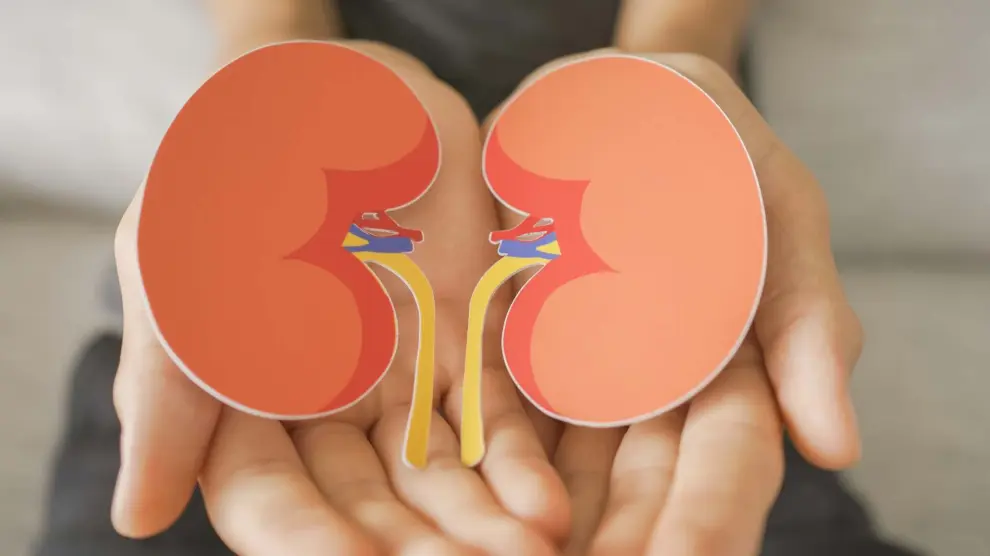Kidney values are measured in the blood and urine. They help assess how well the kidneys are functioning and whether certain diseases are present. We explain what the different kidney values mean for your body. Also, read what to do if your kidney values are poor and how you can prevent them.
Kidney values: At a glance
- Kidney values are measurements that provide information about the functioning of your kidneys and help detect diseases early. They are often determined in the blood, sometimes also in the urine.
- Key kidney tests include creatinine, glomerular filtration rate (GFR), urea, uric acid, cystatin C, and protein in the urine. Doctors typically consider several of these values together for an accurate diagnosis.
- Your kidneys filter toxins and waste products from your blood and produce urine to excrete them. Signs of kidney problems can include high blood pressure, swelling, or changes in urine.
- Elevated creatinine and urea levels indicate impaired kidney function, while a low GFR can also be an indicator of chronic kidney failure. Cystatin C is another kidney function that is less dependent on diet or muscle mass and is therefore often measured in older people.
- A healthy lifestyle with plenty of fruits and vegetables, sufficient fluids, and exercise can prevent kidney disease. Regular checkups to monitor kidney function help detect and treat problems early.
What kidney values are there?
The following measurements are typically taken to assess kidney function or diagnose kidney disease:
- Creatinine and creatinine clearance
- glomerular filtration rate (GFR)
- urea
- uric acid
- Cystatin C
- Protein in the urine
Further down in the article, we will introduce you to some of the most important kidney values in more detail.
Generally speaking, a single lab result isn’t enough for a diagnosis. Therefore, doctors typically measure several of these kidney values, depending on your health condition and symptoms. It’s not uncommon for you to be required to provide both blood and urine samples.
Additional measurements for kidney diagnostics
In addition, other values such as pH, certain proteins, electrolytes such as sodium, potassium, and magnesium inflammatory markers such as leukocytes. If kidney problems are suspected, doctors usually also measure blood pressure and blood sugar. Depending on your specific symptoms and medical history, other measurements may also be taken.
Blockquote: What do the kidneys do? The kidneys look roughly like very large beans and are located to the left and right of the spine, at the lower end of the rib cage. Their job is to filter waste products and harmful substances from the blood and produce urine, with which these waste products are then excreted.
When kidney values are determined
If you suspect you have kidney failure or another kidney disease, you should have your kidney function checked. Doctors often also order liver and kidney function tests as part of checkups and other routine examinations to detect potential organ problems early. It’s important to discuss poor kidney function and any suspicious symptoms with your doctor so that diseases can be detected and treated as early as possible.
What symptoms indicate kidney problems?
There are also a number of symptoms and signs that may indicate kidney problems. These include, but are not limited to:
- A lot of very light urine, foam on the urine, or red urine
- High blood pressure
- Water retention in the legs ( edema)
- Non-specific symptoms such as itching, constant fatigue, and loss of appetite
Blockquote: Prevent kidney disease? The best way to protect your kidneys in the long term is with a healthy lifestyle: plenty of fruit and vegetables, plenty of fluids, regular exercise, a healthy body weight, and avoiding alcohol and smoking. It’s especially important to keep blood pressure and blood sugar within a healthy range, as hypertension and diabetes mellitus are the main causes of chronic kidney failure.
Kidney values for early detection
Chronic kidney failure sounds dramatic, but it often doesn’t cause pain or symptoms for a long time. This also applies to many other diseases related to the kidneys or associated with kidney risks. These include type 2 diabetes and high blood pressure. In general, kidney failure is often the result of other chronic diseases such as diabetes and obesity.
Laboratory tests help identify kidney problems even if you experience no symptoms or only nonspecific symptoms like constant fatigue. As with many other diseases, this is invaluable: The earlier you start treatment and adjust your lifestyle, the better kidney disease can be treated. This saves many people a lot of suffering, later dialysis, or even kidney transplants.
Some kidney values, such as creatinine, are usually part of a checkup at your general practitioner’s office. If you have statutory health insurance, you can have these checkups every three years starting at age 35.
What to do if kidney values are poor?
If several of your kidney values deviate from the reference ranges, your doctor will usually recommend further testing to determine whether kidney disease or another health problem is present.
Treatment depends entirely on the diagnosis. Often, medication and a conscious lifestyle, including a healthier diet, more exercise, and abstinence from alcohol and smoking, can significantly reduce the strain on the kidneys. It’s also important to regularly monitor kidney function and other parameters, such as blood pressure and blood sugar levels, such as long-term blood sugar (HbA1c).
Only in severe cases or at a late stage of kidney disease are measures such as dialysis or a kidney transplant necessary.
Creatinine and creatinine clearance
Creatinine is a breakdown product of creatine, a substance found primarily in muscles where it is used to store energy. Creatinine is excreted almost entirely through the kidneys and urine. Therefore, excessive creatinine in the blood indicates that the kidneys are not filtering the blood optimally.
Doctors often also measure creatinine clearance, which allows them to further assess kidney function. This value indicates how quickly the kidneys filter creatinine from the blood. A blood sample and a 24-hour urine sample are taken, and the clearance value is then calculated. Low creatinine clearance values indicate that the kidneys are not functioning properly.
Read more about this in our health portal article about creatinine.
Glomerular filtration rate (GFR)
The glomerular filtration rate (GFR) is calculated from several other kidney values, including creatinine and cystatin C. It indicates how much fluid the kidneys can filter within one minute.
The GFR is considered accurate and is also used to estimate the stage of certain kidney diseases and the extent of kidney failure. The filtration rate decreases slightly as we age. In people over 65, values slightly below the reference range are therefore not necessarily considered problematic.
A persistently low GFR is considered a clear sign of chronic kidney failure. However, there are other causes for a decreased GFR, such as poorly controlled diabetes mellitus, excessive medication use, high blood pressure, and inflammation.
Table: Stages of chronic kidney disease (CKD) according to GFR value
| Stage CKD | GFR value (ml/min) | Description |
| 1 | ≥ 90 | Kidney function is normal or increased. |
| 2 | 60 – 89 | Slightly impaired kidney function, often without symptoms |
| 3 | 30 – 59 | Moderately impaired renal function, often additionally elevated creatinine and urea levels; possible symptoms: fatigue, decreased performance, increased cardiovascular risk |
| 4 | 15 – 29 | Severely impaired kidney function; impaired detoxification; possible symptoms: nausea, loss of appetite, itching, water retention |
| 5 | < 15 | Chronic kidney failure; dialysis or kidney transplantation is necessary |
Urea
Urea is the waste product that results from protein metabolism in the body. It is produced during the breakdown of nitrogen compounds, especially amino acids, and is subsequently excreted via the kidneys in the urine. This is how the body rids itself of excess nitrogen.
The urea concentration in the blood also reveals something about kidney function. Elevated levels can indicate impaired kidney function, kidney inflammation, and chronic or acute kidney failure.
Unlike creatinine, however, the BUN level also depends heavily on other factors, such as how much protein you consume, how much you drink, and how quickly your body metabolizes proteins. Acute infections, dehydration, and a very high-protein diet are other causes of elevated BUN levels.
Low urea levels are rarely of clinical significance. They may indicate, for example, liver disease, protein deficiency, or chronic alcoholism, and may occur during pregnancy.
Table: Normal values for urea in blood serum (mg/dl)
| Gender | Age (years) | Urea (mg/dl) | Urea (mmol/l) |
| Woman | Under 50 | 15 – 40 | 2.6 – 6.7 |
| Over 50 | 21 – 43 | 3.5 – 7.2 | |
| Man | Under 50 | 19 – 44 | 3.2 – 7.3 |
| Over 50 | 18 – 55 | 3.0 – 9.2 |
uric acid
Uric acid is another byproduct that results from the metabolism of purines. These purines are part of nucleic acid, i.e., our DNA. Uric acid is also largely excreted via the kidneys.
Reference ranges for uric acid may vary slightly depending on the laboratory and gender; they typically range from 5.7 to 7.0 mg/dL in serum. Unlike urea and creatinine, however, uric acid is rarely used to assess kidney function. An elevated uric acid concentration is also called hyperuricemia and is the main cause of gout. Accordingly, uric acid levels are important for diagnosing gout and monitoring its progression.
Whether uric acid concentrations are also related to kidney disease is controversial. Some scientists suspect that a slightly elevated concentration may not be relevant or even beneficial in chronic kidney failure.
Elevated uric acid levels can also indicate congenital metabolic disorders, poorly controlled diabetes mellitus, fasting, a high-fat diet, an underactive thyroid, or poisoning (e.g., lead poisoning ). Furthermore, certain high-fat foods contain a lot of purines. If you eat a lot of meat, for example, your body has to break down more purines and produce more uric acid.
Low uric acid levels rarely occur naturally. They are usually the result of an overdose of gout medications that lower uric acid levels.
Cystatin C
Cystatin C is a protein that is produced during many metabolic processes and can be detected in the blood. When kidney function is impaired, the kidneys can no longer properly filter cystatin C from the blood. The concentration of cystatin C in the blood then increases.
The cystatin C level is considered a strong marker for renal insufficiency. It is also used to calculate the glomerular filtration rate (GFR). The reference range for cystatin C is typically between 0.50 mg/L and 0.96 mg/L, although values below 1.4 mg/L can also be considered normal.
The advantage of cystatin C as a kidney test: Protein is less dependent on your diet and muscle mass than, for example, creatinine. Doctors often prefer the cystatin C test in older people, for example, because creatinine levels can be unreliable in older people due to their lower muscle mass.
Urine protein and protein-creatinine ratio (UPCR)
Normally, the kidneys filter proteins from the blood and return them to the body, so only very small amounts are excreted in the urine. If more than 150 milligrams of protein per liter (mg/l) are detected in several urine samples within 24 hours, this is referred to as proteinuria.
Proteinuria can be benign and only last for a short time, for example, due to strenuous physical exertion, an infection with fever, or dehydration. If protein excretion remains this high for a long time, it is a possible sign of kidney disease, diseases such as diabetes mellitus, hypertension, or systemic diseases such as lupus erythematosus.
In addition to the urine protein test, the urine protein-to-creatinine ratio (UPCR) can also be determined. This involves a laboratory measuring the amount of protein and creatinine in a single urine sample. A high UPCR value indicates excess protein in the urine, which may indicate kidney damage and certain diseases. Studies have shown that when these values deviate from the normal range, this indicates that kidney disease will later become more severe and have more complications. This value can therefore help doctors, for example, identify risks to you early on.























+ There are no comments
Add yours